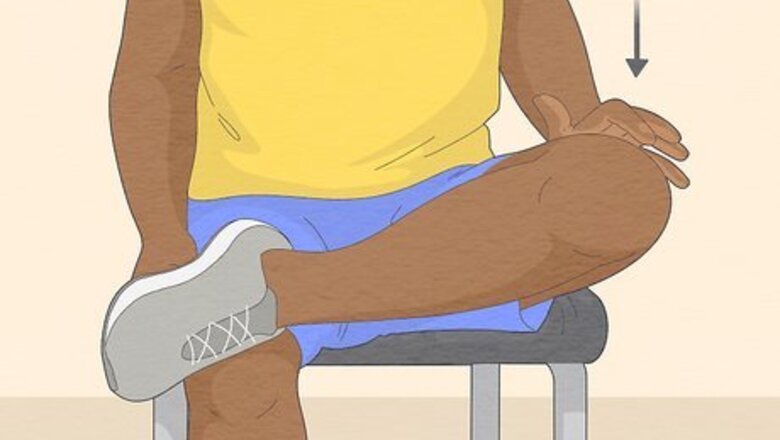
views
- Try stretches and exercises to treat knock knees at home. Do things like a figure 4 stretch, a butterfly stretch, and squats.
- Wear running shoes to support your knees and hips while you walk. Eat a healthy diet to support bone health, and lose weight if you need to.
- Talk to your doctor about surgical options if your knock knees are severe or if you have arthritis.
Knock Knee Exercises
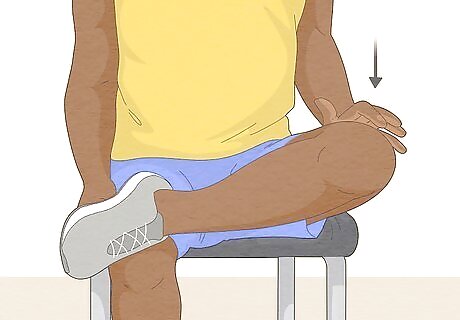
Figure 4 stretch Sit in a chair and bring 1 foot up onto the opposite knee. With your knee pointed out to the side, slowly push down on the inside of your knee to stretch your hips. Release after 1 to 2 seconds, then repeat the stretch 8 to 10 times on both legs. Stretching your hips and the tops of your legs opens up your hip flexors to allow your knees to turn outward. When your hips turn outward, your knees do, too. You can do most knock knee exercises and stretches 6 to 7 days per week. However, if they cause you pain or discomfort, talk to your doctor before continuing.
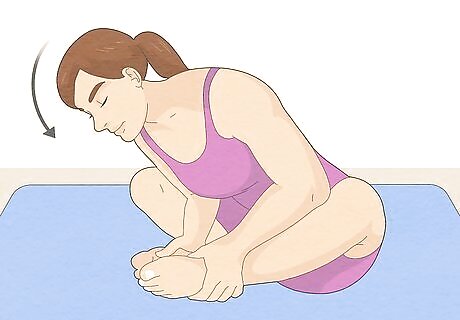
Butterfly stretch Sit on the ground with your legs straight out in front of you. Slowly bring your feet in toward yourself, letting your knees flop to the side. Grab your ankles and push down on your knees with your elbows to stretch your groin area for 30 seconds to 1 minute. Stretching your groin allows your hips to turn outward, which will help your knees turn outward, too.
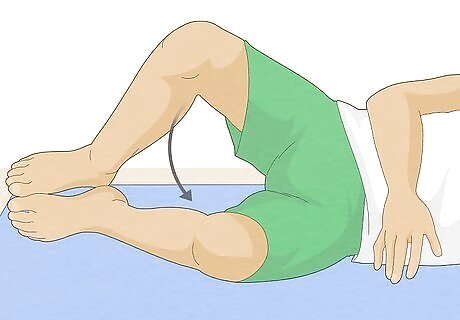
Clamshells Lie down on one side with your knees slightly bent. Keeping your bottom leg on the floor, slowly raise your top knee to the sky, keeping your feet together. Raise and lower your knee 8 to 10 times, then switch sides. This exercise strengthens your hip flexors and your thighs. When your hip flexors and thighs are strong, they can turn your knees outward instead of letting them fall inward.
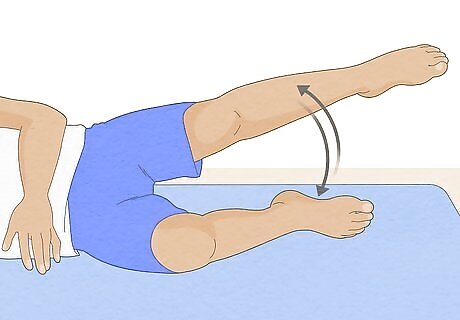
Lying leg lifts Lie down on one side with your legs straight. Keeping your bottom leg on the ground, lift your top leg up into the air at about a 45-degree angle to the ground. Slowly lower your leg, then lift it up 8 to 10 more times before switching sides. Doing this will strengthen your outer thighs and your glutes. These muscles help turn your hips and your knees outward.
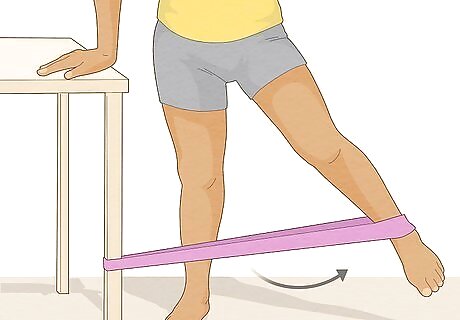
Leg band stretches Attach a resistance band to a solid object at about ankle height, like a chair or table leg. Stand next to the solid object and attach the band to your outside leg. Slowly raise your leg out to the side, keeping your hips straight. Hold the position for 2 seconds, then lower your leg. This exercise strengthens your hip flexors and the muscles in your thighs, both of which control the direction of your knees.
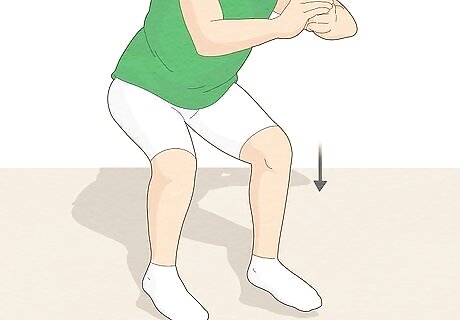
Squats Do squats by standing with your feet hip-width apart. With your feet pointed forward, slowly bend your knees and engage your glutes to lower your body down. When your legs create a 90-degree angle, slowly push yourself back up. Try to do 10 squats in total. Squats strengthen your quads, glutes, and hamstrings all at the same time.
Lifestyle Changes
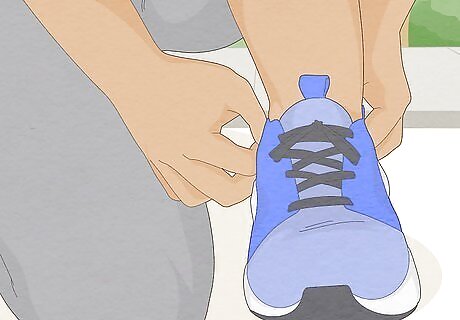
Wear well-fitting running shoes as your everyday shoes. Good running shoes can do a lot to take the strain off your knees and ankles, and you can benefit from them even if you aren’t an athlete. Look for shoes that are designed to correct overpronation (the foot rolling inward when you run or walk). To get shoes fitted, go to a store that caters to runners. They can recommend shoe brands to you and have you try them on for the perfect fit.
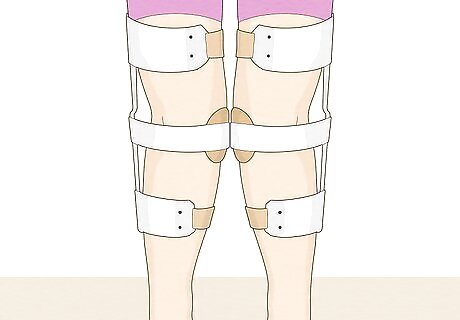
Use leg braces or orthotic shoes for extra support and gait correction. Your doctor or physical therapist may recommend special shoes or braces that can help correct the alignment of your feet and knees. These devices can also take some of the pressure off your knees, preventing your knock knees from getting worse. Ask your doctor or physical therapist what kinds of devices will work best for you. Many people with knock knees have one leg that’s longer than the other. Orthotic shoes can help correct the difference, making it easier to walk and run without putting strain on your knees and feet. Additionally, orthotic shoes can prevent your feet from rolling inward as you walk. This is a common gait issue in people with knock knees. You may also benefit from a leg brace that supports the outside part of your knee joint.
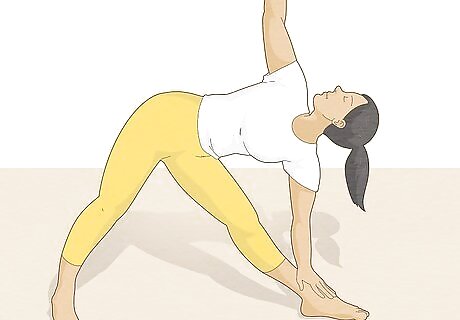
Strengthen your knees with yoga. There are a variety of yoga poses and exercises you can try to build strength, flexibility, and stability in your knees. Yoga is particularly helpful for treating knee problems when combined with physical therapy. Look for a qualified yoga therapist who has experience treating knee problems, or ask your doctor of physical therapist to recommend someone. They can teach you how to do the poses and exercises correctly so that you do not further injure your knees. Some good knee-strengthening poses include the Warrior poses and the Triangle pose.
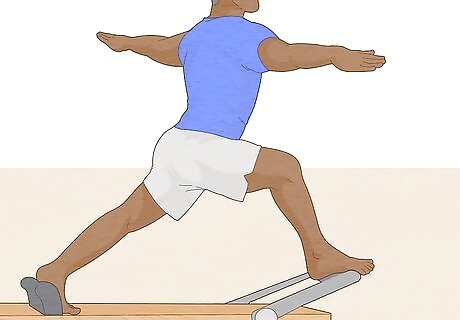
Do a knee-friendly Pilates workout. You can also use Pilates to strengthen your knees, relieve tension, and improve the mobility of your knee joints. Find a Pilates instructor who can guide you through some good knee-strengthening exercises, or ask your doctor or physical therapist to recommend someone.

Eat a diet that supports your bone and joint health. In addition to exercising safely and appropriately, you can protect and support your knees by eating foods that strengthen your bones and the surrounding tissues. Eat foods like: A range of colorful fruits and vegetables, especially antioxidant-rich choices like berries and dark, leafy greens. Foods that increase your intake of omega-3 fatty acids, such as fish, seeds and nuts, and vegetable oils. Lean proteins, such as fish, poultry breast, and beans. Anti-inflammatory spices, such as turmeric and ginger. Foods rich in calcium and vitamin D, such as dairy products, eggs, fortified cereals, and canned fish with bones.
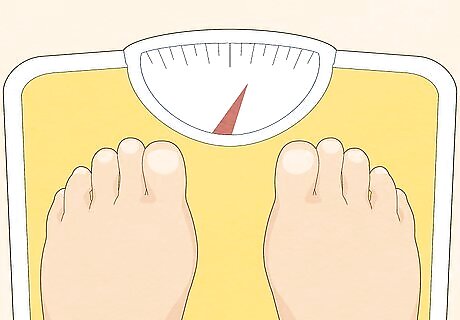
Work on losing weight if your knock knees are related to obesity. Carrying extra body weight can put strain on your knees, making your knock knees worse. Stick to a healthy diet and exercise regularly to get down to a healthy weight and take pressure off your knees. If you’re concerned about losing weight safely, talk to your doctor or a dietitian for guidance.
Surgical Options

Osteotomy Osteotomy is the most common type of surgery to correct knock knees in older teens and adults. This procedure involves cutting out part of one of the leg bones surrounding the knee and adjusting the bone to permanently correct the alignment of the joint. Ask your doctor to refer you to an orthopedic surgeon if they recommend an osteotomy. Most people stay in the hospital for 1 to 2 days during this surgery. A full recovery can take up to 6 months.Tip: Corrective knee surgeries like osteotomy and knee replacement typically involve implanting hardware (such as plates, screws, and artificial joints) into the knee. Let your doctor know if you are allergic to any metals or other materials so that they can select appropriate hardware.

Knee replacement surgery If your knock knees are caused by or associated with severe arthritis, your doctor may recommend a knee replacement surgery. This involves cutting away damaged bone from your knee and thigh and replacing it with artificial bone. Talk to your doctor if you have arthritis and knock knees to find the best option for you. Full recovery from this surgery usually takes 3 to 6 weeks.
Causes of Knock Knees
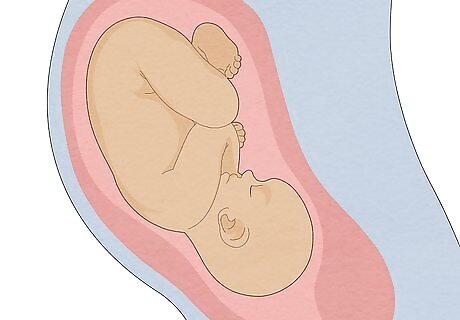
Knock knees are usually caused by your position in the womb. Usually, infants will develop knock knees in their mother’s womb because of their folded position. For many people, knock knees straighten out during puberty, and aren’t much of a problem during adulthood. If you’ve had knock knees since you were a child, they may be caused by a genetic condition. Certain genes make knock knees stick around through puberty and until adulthood.
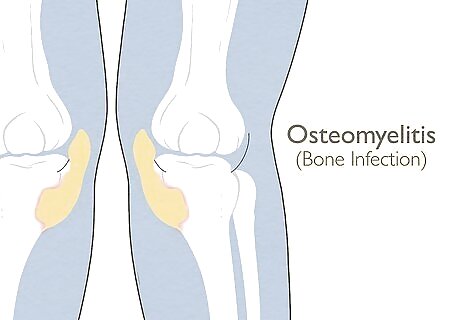
Knock knees can also be caused by medical problems or diseases. In rare cases, knock knees happen later in life. You might develop knock knees as a result of an injury to the shinbone, osteomyelitis (bone infection), obesity, or rickets.
Symptoms of Knock Knees
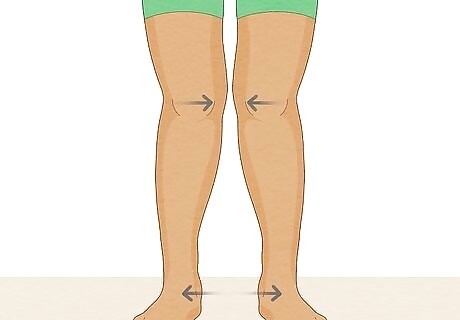
Separation of the ankles when the knees are together Stand up straight with your legs as close together as possible. When your knees touch, are your ankles far apart? If so, it’s likely that your knees are turning inward, meaning you have knock knees.
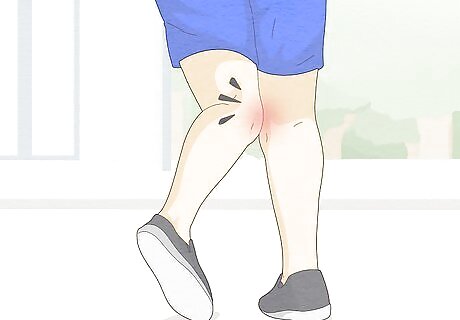
Difficulty walking The position of your knees may affect how well and how quickly you walk. If you find that your knees touch and rub as you move, you likely have knock knees.
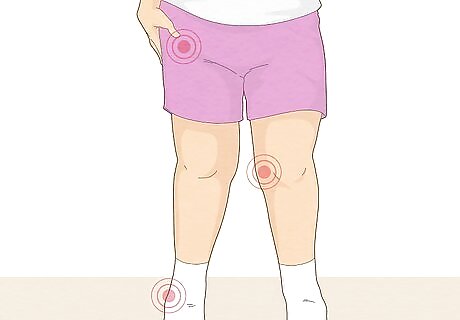
Pain in the knees, feet, hip, or ankles Not everyone with knock knees experiences pain, but some people do. The position of your knees may cause pain or irritation in your legs, especially after you walk a long distance.
Knock Knees in Children
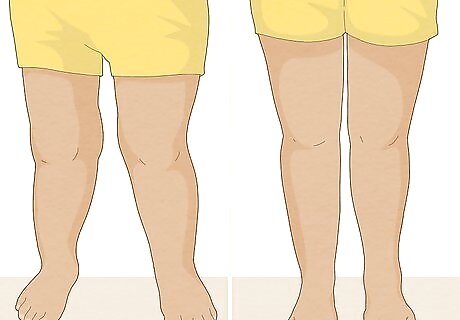
Take a wait-and-see approach for children under 7. It’s very common for young children to develop knock knees as the muscles in their legs develop. The condition typically first appears in children between the ages of 2 and 5, and most often goes away by the time the child is 7. While it’s a good idea to talk to your child’s doctor if they develop knock knees at this age, they likely won’t need any treatment. If your child develops knock knees before the age of 2, talk to their pediatrician.




















Comments
0 comment